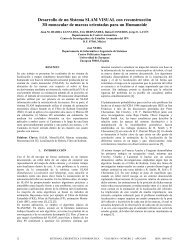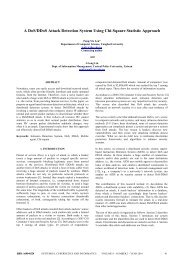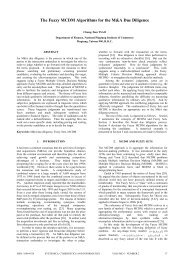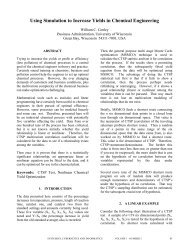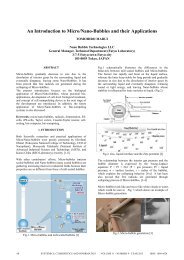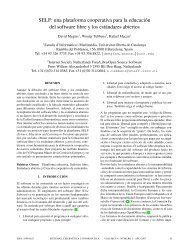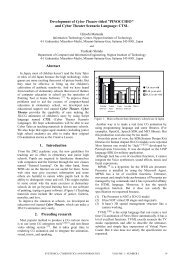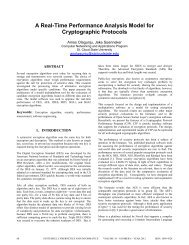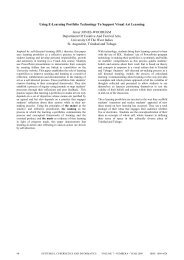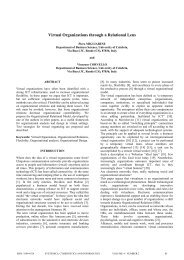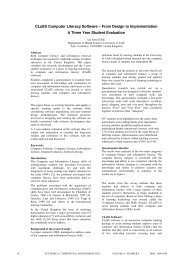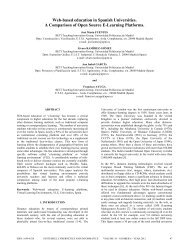IRIS RECOGNITION USING WAVELET
IRIS RECOGNITION USING WAVELET
IRIS RECOGNITION USING WAVELET
Create successful ePaper yourself
Turn your PDF publications into a flip-book with our unique Google optimized e-Paper software.
These factors can severely affect iris matching results. In order<br />
to get accurate results, it is necessary to eliminate these factors.<br />
To achieve this, localized iris is transformed into polar<br />
coordinates system. The Cartesian to polar transformation was<br />
suggested by Daugman [1]. Localized iris is transformed into a<br />
rectangular block of size to achieve size independent iris<br />
recognition and this process helps to improve recognition<br />
results. 48x448 resolution size is used for whole iris.<br />
Whole iris [0,360 o ] is not transformed in the proposed system<br />
because of the fact that most of the irises are affected by upper<br />
and lower eyelids. Experiments were conducted by normalizing<br />
the iris from [60,120 o ] and [240,300 o ], ignoring both upper and<br />
lower eyelid areas as indicated in Figure 3. Size of rectangular<br />
block is reduced accordingly. Left and right images of size<br />
48x74 are obtained. By applying this approach, detection time of<br />
upper and lower eyelids and 66% cost of the polar<br />
transformation is saved. Results have shown that information in<br />
these portions of iris is good enough for iris recognition.<br />
Right image<br />
Image Enhancement<br />
Left image<br />
Figure 3: Ignoring upper and lower eyelids<br />
In order to obtain best features for iris recognition, polar<br />
transformed image is enhanced using contrast-limited adaptive<br />
histogram equalization [9] on left and right images separately.<br />
Results of image before and after enhancement are shown in<br />
Figure 4.<br />
systems. Different experiments were conducted and Haar,<br />
Symlet, Biorthogonal and Mexican hat wavelets were used to<br />
extract features. Recognition results obtained from experiments<br />
using different wavelets are shown in Figure 5. Approximation<br />
coefficients at Level-1 of Haar, Symlet and Biorthogonal have<br />
been used as features while YAWTB’s [7] CWT function is<br />
used to implement the Mexican hat at scale 4 and decomposed it<br />
to get features. Wavelets are applied separately on left and right<br />
images and then combined to make 1D feature vector.<br />
4. MATCHING<br />
Matching value of two iris codes is calculated on the basis of<br />
their average absolute differences. Iris codes with minimum<br />
matching value are considered as best match. Matching value is<br />
calculated as:<br />
1 m<br />
MV = ∑ DBi<br />
NCi<br />
m i=<br />
1<br />
−<br />
(2)<br />
Where m is the length of the feature vector. DB is the iris<br />
code stored in the database and NC is the new iris code to be<br />
matched in the database. Corresponding values in the codes are<br />
matched and matching value (MV) is computed. Database code<br />
that produces minimum matching value with new code is<br />
considered as matched subject. If matching value is smaller than<br />
separation point then it is considered matched otherwise it is not<br />
matched.<br />
No shifts in the iris code were used. Only average is used to<br />
compensate rotation of iris that reduced the number of iris codes<br />
stored in the database and increase the speed of matching<br />
process to some extent.<br />
5. EXPERIMENTS AND RESULTS<br />
The proposed system has been developed in Matlab 7 and using<br />
P-IV 3.2 GHz system available in the department laboratory and<br />
has been tested on 410 images from 82 classes of MMU iris<br />
image database. Two types of experiments have been conducted<br />
to test the performance of the system.<br />
Before<br />
After<br />
(a) Left image<br />
In the first experiment, randomly selected three images of 72<br />
classes (216 images) and their average were used for training<br />
purpose and two images of these 72 classes (144 images) were<br />
used for matching while 10 classes (50 images) were also used<br />
in matching process as imposter.<br />
Before<br />
After<br />
(b) Right image<br />
Figure 4: (a) Left image before and after enhancement. (b) Right<br />
image before and after enhancement<br />
3. FEATURE EXTRACTION<br />
Feature extraction is the most important part in recognition<br />
In the second experiment, only average of randomly selected<br />
three images of 72 classes (216 images) was used for training<br />
purpose to reduce the number of codes in the database and all<br />
images of these 72 classes (360 images) were used for matching<br />
while 10 classes (50 images) were also used in matching process<br />
as imposter.<br />
Selection of separation point is critical. If small separation point<br />
is selected there will be less False Acceptance Rate (FAR) and<br />
more False Rejection Rate (FRR). By increasing the value of<br />
separation point more FAR and less FRR will be achieved.<br />
There must be a trade off between FAR and FRR. Receiver<br />
Operating Characteristic (ROC) curve is used as a standard to<br />
ISSN: 1690-4524<br />
SYSTEMICS, CYBERNETICS AND INFORMATICS VOLUME 11 - NUMBER 4 - YEAR 2013<br />
53



